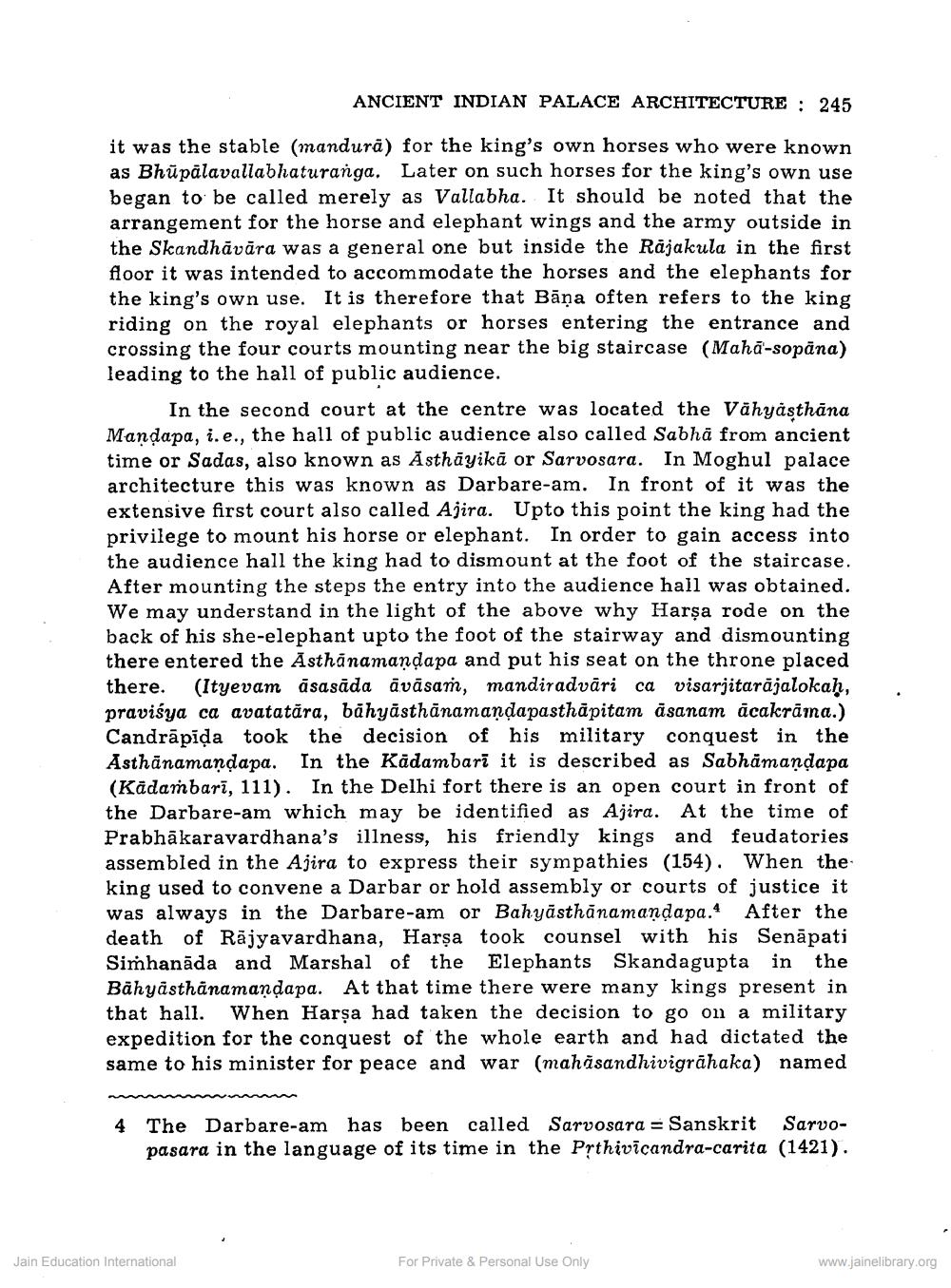Book Title: Ancient Indian Palace Architecture Author(s): V S Agarwala Publisher: Z_Mahavir_Jain_Vidyalay_Suvarna_Mahotsav_Granth_Part_1_012002.pdf and Mahavir_Jain_Vidyalay_Suvarna_ View full book textPage 4
________________ ANCIENT INDIAN PALACE ARCHITECTURE : 245 it was the stable (mandura) for the king's own horses who were known as Bhūpälavallabhaturanga. Later on such horses for the king's own use began to be called merely as Vallabha. It should be noted that the arrangement for the horse and elephant wings and the army outside in the Skandhāvāra was a general one but inside the Rajakula in the first floor it was intended to accommodate the horses and the elephants for the king's own use. It is therefore that Bāņa often refers to the king riding on the royal elephants or horses entering the entrance and crossing the four courts mounting near the big staircase (Maha-sopāna) leading to the hall of public audience. In the second court at the centre was located the Vāhyasthāna Mandapa, i.e., the hall of public audience also called Sabhā from ancient time or Sadas, also known as Ăsthāyikā or Sarvosara. In Moghul palace architecture this was known as Darbare-am. In front of it was the extensive first court also called Ajira. Upto this point the king had the privilege to mount his horse or elephant. In order to gain access into the audience hall the king had to dismount at the foot of the staircase. After mounting the steps the entry into the audience hall was obtained. We may understand in the light of the above why Harsa rode on the back of his she-elephant upto the foot of the stairway and dismounting there entered the Asthānamandapa and put his seat on the throne placed there. (Ityevam āsasāda āvāsam, mandiradvāri ca visarjitarājalokah, praviśya ca avatatāra, bāhyāsthānamandapasthāpitam āsanam acakrāma.) Candrāpida took the decision of his military conquest in the Asthānamandapa. In the Kadambarī it is described as Sabhāmaņdapa (Kādambarī, 111). In the Delhi fort there is an open court in front of the Darbare-am which may be identified as Ajira. At the time of Prabhākaravardhana's illness, his friendly kings and feudatories assembled in the Ajira to express their sympathies (154). When the king used to convene a Darbar or hold assembly or courts of justice it was always in the Darbare-am or Bahyāsthānamandapa. After the death of Rajyavardhana, Harşa took counsel with his Senāpati Simhanada and Marshal of the Elephants Skandagupta in the Bähyästhānamandapa. At that time there were many kings present in that hall. When Harsa had taken the decision to go on a military expedition for the conquest of the whole earth and had dictated the same to his minister for peace and war (mahasandhivigrāhaka) named 4 The Darbare-am has been called Sarvosara = Sanskrit Sarvopasara in the language of its time in the Pythivicandra-carita (1421). Jain Education International For Private & Personal Use Only www.jainelibrary.orgPage Navigation
1 2 3 4 5 6 7 8 9 10 11 12 13 14 15 16 17 18
